#and Security-Regolith Explorer
Text
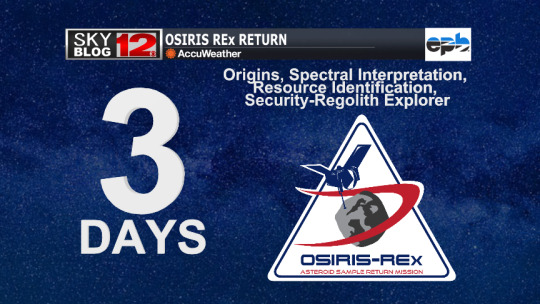
"NASA is inviting the public to take part in virtual activities ahead of the OSIRIS-REx (Origins, Spectral Interpretation, Resource Identification, and Security-Regolith Explorer) asteroid sample return mission. Members of the public can register to attend the sample return virtually."
#OSIRIS-REx#Origins#Spectral Interpretation#Resource Identification#and Security-Regolith Explorer#asteroid sample return
0 notes
Video
OSIRIS-REx Sample Return (NHQ202309240001) by NASA HQ PHOTO
Via Flickr:
The sample return capsule from NASA’s OSIRIS-REx mission is seen shortly after touching down in the desert, Sunday, Sept. 24, 2023, at the Department of Defense's Utah Test and Training Range. The sample was collected from the asteroid Bennu in October 2020 by NASA’s OSIRIS-REx spacecraft. Photo Credit: (NASA/Keegan Barber)
#Asteroid Sample Return#Origins Spectral Interpretation Resource Identification Security-Regolith Explorer (OSIRIS-REx)#Utah#Utah Test and Training Range#Origins Spectral Interpretation Resource Identification Security#Dugway#UT#NASA#Keegan Barber#flickr
1 note
·
View note
Text
Touchdown! Alien Rock Returned from Billions of Miles Away!

After traveling billions of miles to Bennu and back, the OSIRIS-REx spacecraft released its sample capsule toward Earth’s atmosphere at 6:42 a.m. EDT (4:42 a.m. MDT). The spacecraft was 63,000 miles (102,000 kilometers) from Earth’s surface at the time – about one-third the distance from Earth to the Moon.
Traveling at 27,650 mph (44,500 kph), the capsule pierced the atmosphere at 10:42 a.m. EDT (8:42 a.m. MDT), off the coast of California at an altitude of about 83 miles (133 kilometers). Within 10 minutes, it landed on the military range. Along the way, two parachutes successfully deployed to stabilize and slow the capsule down to a gentle 11 mph (18 kph) at touchdown
“The returned samples collected from Bennu will help scientists worldwide make discoveries to better understand planet formation and the origin of organics and water that led to life on Earth, as well as benefit all of humanity by learning more about potentially hazardous asteroids”
After years of anticipation and hard work by NASA’s OSIRIS-REx (Origins, Spectral Interpretation, Resource Identification and Security – Regolith Explorer) team, a capsule of rocks and dust collected from asteroid Bennu finally is on Earth. It landed at 8:52 a.m. MDT (10:52 a.m. EDT) on Sunday, in a targeted area of the Department of Defense’s Utah Test and Training Range near Salt Lake City.
Within an hour and a half, the capsule was transported by helicopter to a temporary clean room set up in a hangar on the training range, where it now is connected to a continuous flow of nitrogen.
Getting the sample under a “nitrogen purge,” as scientists call it, was one of the OSIRIS-REx team’s most critical tasks today. Nitrogen is a gas that doesn’t interact with most other chemicals, and a continuous flow of it into the sample container inside the capsule will keep out earthly contaminants to leave the sample pure for scientific analyses.
76 notes
·
View notes
Text

Measuring moon dust to fight air pollution
Moon dust, or regolith, isn't like the particles on Earth that collect on bookshelves or tabletops—it's abrasive and it clings to everything. Throughout NASA's Apollo missions to the moon, regolith posed a challenge to astronauts and valuable space hardware.
During the Apollo 17 mission, astronaut Harrison Schmitt described his reaction to breathing in the dust as "lunar hay fever," experiencing sneezing, watery eyes, and a sore throat. The symptoms went away, but concern for human health is a driving force behind NASA's extensive research into all forms of lunar soil.
The need to manage the dust to protect astronaut health and critical technology is already beneficial on Earth in the fight against air pollution.
Working as a contributor on a habitat for NASA's Next Space Technologies for Exploration Partnerships (NextSTEP) program, Lunar Outpost Inc. developed an air-quality sensor system to detect and measure the amount of lunar soil in the air that also detects pollutants on Earth.
Originally based in Denver, the Golden, Colorado-based company developed an air-quality sensor called the Space Canary and offered the sensor to Lockheed Martin Space for its NextSTEP lunar orbit habitat prototype. After the device was integrated into the habitat's environmental control system, it provided distinct advantages over traditional equipment.
Rebranded as Canary-S (Solar), the sensor is now meeting a need for low-cost, wireless air-quality and meteorological monitoring on Earth. The self-contained unit, powered by solar energy and a battery, transmits data using cellular technology.
It can measure a variety of pollutants, including particulate matter, carbon monoxide, methane, sulfur dioxide, and volatile organic compounds, among others. The device sends a message up to a secure cloud every minute, where it's routed to either Lunar Outpost's web-based dashboard or a customer's database for viewing and analysis.
The oil and gas industry uses the Canary-S sensors to provide continuous, real-time monitoring of fugitive gas emissions, and the U.S. Forest Service uses them to monitor forest-fire emissions.
"Firefighters have been exhibiting symptoms of carbon monoxide poisoning for decades. They thought it was just part of the job," explained Julian Cyrus, chief operating officer of Lunar Outpost. "But the sensors revealed where and when carbon monoxide levels were sky high, making it possible to issue warnings for firefighters to take precautions."
The Canary-S sensors exemplify the life-saving technologies that can come from the collaboration of NASA and industry innovations.
IMAGE: While astronaut Gene Cernan was on the lunar surface during the Apollo 17 mission, his spacesuit collected loads of lunar dust. The gray, powdery substance stuck to the fabric and entered the capsule causing eye, nose, and throat irritation dubbed "lunar hay fever." Credit: NASA
3 notes
·
View notes
Text
Moon Day





(All of my moon pics from my photo gallery)
On July 20, 2024, I set up Moon Base Alpha, a stable habitat for their lunar mission. I worked diligently to establish a secure living and working environment, ensuring all life support systems were functioning perfectly. I embarked on an exploration mission around the landing site, collecting samples of lunar regolith and rocks to uncover secrets about the moon's history.
The solar panel deployment was crucial for ensuring a sustainable power source, as it unfurled effortlessly, soaking up abundant sunlight. During my exploration, I discovered an unusual rock formation with crystalline structures, which could be a rare type of lunar mineral. Subsurface ice deposits were also discovered, providing a vital resource for water and oxygen.
Despite challenges, such as a communication glitch with Mission Control and the pervasive lunar dust, I was able to resolve the issue and re-establish contact. The pervasive lunar dust caused minor visibility issues and concerns about its impact on machinery. I will need to devise better strategies to mitigate its effects in the coming days.
As I settle into my sleeping pod, gazing out at the desolate beauty of the lunar surface, I am filled with a profound sense of wonder and gratitude. Today marked the beginning of my lunar adventure, and I'm eager to see what tomorrow holds. The moon holds many mysteries, and I'm here to uncover them, one small step at a time.
4 notes
·
View notes
Photo
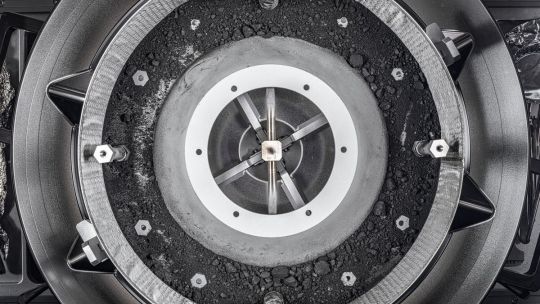
1st look at asteroid Bennu samples suggests space rock may be 'a fragment of an ancient ocean world' | Space
'We're going to be busy for a long, long time. This is an enormous amount of sample for us.’
Scientists are now inspecting snagged, bagged and tagged bits and pieces from asteroid Bennu, the cosmic mother lode delivered by NASA's Origins, Spectral Interpretation, Resource Identification and Security — Regolith Explorer mission.
Known in acronymic astro-speak as OSIRIS-REx, that seven-year-long voyage brought home the goods via a sample return canister that came to full stop on Sept. 24, 2023, parachuting into a remote stretch of the Department of Defense's Utah Test and Training Range. Those specimens from afar are believed to contain the leftovers from the formation of the solar system 4.5 billion years ago.
Space.com caught up with two leading scientists now engaged in extracting what those darkish asteroid particles are illuminating, sorting out how these materials exported from Bennu came to be. But also what insights they hold for the origin of the worlds within our solar system, including Earth. ...
4 notes
·
View notes
Link
It’s been another great year at NASA’s Ames Research Center in California’s Silicon Valley. Join us as we review some of the highlights of the science, engineering, and innovation from 2023. Announcing a New Innovation Hub Planned for NASA Research Park at Ames NASA Berkeley Space Center is a proposed new campus of the University of California, Berkeley, and an innovation hub for research and advances in astronautics, aeronautics, quantum computing, climate studies, and more. Planning to join Ames as a tenant of our NASA Research Park in Silicon Valley, the new campus aims to bring together researchers from the private sector, academia, and the government to tackle the complex scientific, technological, and societal issues facing our world. Mapping Water Distribution on the Moon’s South Pole NASA Using data collected by the now-retired Stratospheric Observatory for Infrared Astronomy (SOFIA), researchers shared the first detailed, wide-area map of water distribution on the Moon. Understanding how much water lies beneath the lunar surface, and how it’s distributed, will help guide future missions like VIPER, as well as prospective sites for human habitats. Colliding Moons May Have Formed Saturn’s Rings NASA New research suggests Saturn’s icy moons and rings were formed by a collision a few hundred million years ago, creating debris that gathered into the planet’s dusty, icy rings or clumped together to form moons. NASA and Airlines Partner to Save Fuel and Reduce Delays NASA/James Blair This year, NASA partnered with five major U.S. airlines on an air traffic decision-making tool that saved more than 24,000 pounds of jet fuel in 2022 for flights departing from Dallas-Fort Worth International Airport and Dallas Love Field Airport. Partners include American Airlines, Delta Air Lines, JetBlue Airways, Southwest Airlines and United Airlines. NASA Leaders View Climate Science, Wildfire Innovations at Ames NASA/Dominic Hart NASA’s top leadership, industry experts, and legislative officials visited Ames in April to learn about about the center’s climate science efforts and innovations in aeronautics that will help scientists and engineers better understand climate change and mitigate natural disasters like wildland fires. Starling Takes Flight Blue Canyon Technologies/NASA In July NASA’s Starling mission, managed at Ames, launched four CubeSats into low-Earth orbit to test robotic swarm technologies for space. You can track mission milestones via the Small Satellite Missions blog, and follow the mission live in NASA’s Eyes on the Solar System 3D visualization. NASA’s First Robotic Moon Rover NASA/Robert Markowitz This year engineers began assembling NASA’s first robotic Moon rover, VIPER — short for the Volatiles Investigating Polar Exploration Rover — and the agency is giving the public a front row seat to watch along as the rover takes shape. While individual components, such as the rover’s science instruments, lights, and wheels, were assembled and tested, the VIPER team also completed software development, mission planning, and tricky tests of the rover’s ability to drive off the Astrobotic Griffin lunar lander and onto the lunar surface. Bringing Home Ancient Space Rocks NASA/Keegan Barber NASA’s OSIRIS-REx mission – short for the Origins, Spectral Interpretation, Resource Identification, and Security-Regolith Explorer – returned to Earth in Sept. 2023, bringing with it extraterrestrial rocks and dust that it scooped up from an asteroid estimated to be 4.5 billion years old. Ames contributed to the spacecraft’s heat shield, anti-contamination systems, post-landing sample curation, and more. Preparing to Send Yeast to the Moon’s Surface for Astronaut Health NASA/Dominic Hart NASA’s plans to explore the Moon and eventually go to Mars will bring humans deeper into space for longer duration missions than ever before. These extended missions beyond low Earth orbit pose certain health risks to astronauts. The Lunar Explorer Instrument for Space Biology Applications team is preparing an experiment to study yeast’s biological response to the lunar environment to help understand and mitigate health risks for astronauts. X-59 Team Moves Toward First Flight in 2024 Lockheed Martin/Gary Tice This year, NASA’s X-59 team installed the finishing touches to the aircraft’s tail structure and moved it from its assembly facility to the flight line to perform structural testing. The X-59 quiet supersonic aircraft will take its first flight in 2024. Celebrating a Stellar Year for Webb Telescope Science NASA, ESA, CSA, STScI, and S. Crowe (University of Virginia) The James Webb Space Telescope’s Near-Infrared Camera instrument produced a feast for the eyes with a view into a star-forming region, named Sagittarius C, in the heart of the Milky Way. The image reveals a portion of the dense center of our galaxy in unprecedented detail, including never-before-seen features astronomers have yet to explain. Supercomputer Simulations Lead to Air and Space Innovations NASA Simulations and models developed using technology at the NASA Advanced Supercomputing Facility (NAS) help researchers and engineers develop innovations in air and space. Modeling turbofan engines could lead to designs that reduce engine noise and improve efficiency by understanding where noise is generated inside the machine. S-MODE Sails the Seas and Soars through the Sky NASA/Avery Snyder The Sub-Mesoscale Ocean Dynamics Experiment (S-MODE) logged its final field expedition, and they took a team from the TODAY Show along for the ride. S-MODE combined airborne instruments, research ships, and autonomous ocean gliders to get an unprecedented look at how gas and heat exchange at the ocean’s surface impacts Earth’s climate. From Intern to Astronaut, and Back to Ames NASA/Dominic Hart NASA astronaut Jessica Watkins, who was once an intern at Ames, returned to the Bay Area in Feb. 2023 to visit with local elementary schools and speak with Ames employees. Watkins started her career with NASA at Ames, where she conducted research on Mars soil simulant supporting the Phoenix Mars Lander mission. Second Gentleman Joins East Bay Kids for STEM Activities NASA/Dominic Hart Nearly 100 East Bay kids and their families got to experience the thrill of “launching a rocket” and “making clouds” at a fun-filled STEM event hosted in honor of Women’s History Month at the East Oakland Youth Development Center in Oakland, California, in March 2023. Second Gentleman Douglas Emhoff, NASA Ames Research Center Director Dr. Eugene Tu, and NASA astronaut Dr. Yvonne Cagle joined kids at the Manzanita Community School for hands-on activities and to distribute approximately 500 STEM Artemis Learning Lunchboxes aimed to inspire the Artemis generation to learn about NASA’s Artemis Program. Top Leaders in Our Midst Hailed from the White House and Australia NASA/Dominic Hart In January, U.S. President Joe Biden landed at Moffett Federal Airfield, at Ames, on his way to visit storm-damaged regions in the state. Research conducted at our Silicon Valley center could help predict extreme climate-related weather events. Later in the spring, Vice President Kamala Harris arrived at Moffett before delivering remarks at a local company, and leaders of the Australian Space Agency visited Ames to learn about the center’s missions supporting NASA’s Artemis program, including the VIPER Moon rover, which will launch to the lunar South Pole in late 2024.
2 notes
·
View notes
Text
Initial studies of the 4.5-billion-year-old asteroid Bennu sample collected in space and brought to Earth by NASA show evidence of high-carbon content and water, which together could indicate the building blocks of life on Earth may be found in the rock. NASA made the news Wednesday from its Johnson Space Center in Houston where leadership and scientists showed off the asteroid material for the first time since it landed in September.
This finding was part of a preliminary assessment of NASA’s OSIRIS-REx (Origins, Spectral Interpretation, Resource Identification and Security – Regolith Explorer) science team.
“The OSIRIS-REx sample is the biggest carbon-rich asteroid sample ever delivered to Earth and will help scientists investigate the origins of life on our own planet for generations to come,” said NASA Administrator Bill Nelson. “Almost everything we do at NASA seeks to answer questions about who we are and where we come from. NASA missions like OSIRIS-REx will improve our understanding of asteroids that could threaten Earth while giving us a glimpse into what lies beyond. The sample has made it back to Earth, but there is still so much science to come – science like we’ve never seen before.”
Although more work is needed to understand the nature of the carbon compounds found, the initial discovery bodes well for future analyses of the asteroid sample. The secrets held within the rocks and dust from the asteroid will be studied for decades to come, offering insights into how our solar system was formed, how the precursor materials to life may have been seeded on Earth, and what precautions need to be taken to avoid asteroid collisions with our home planet.
3 notes
·
View notes
Text

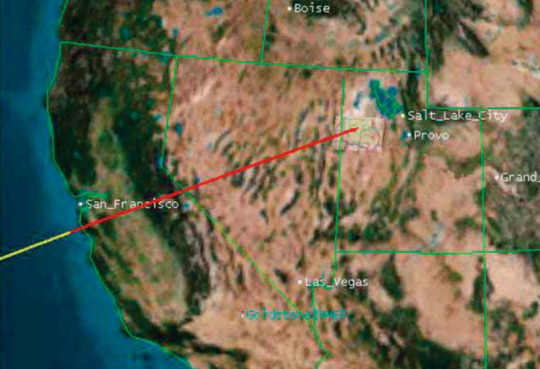
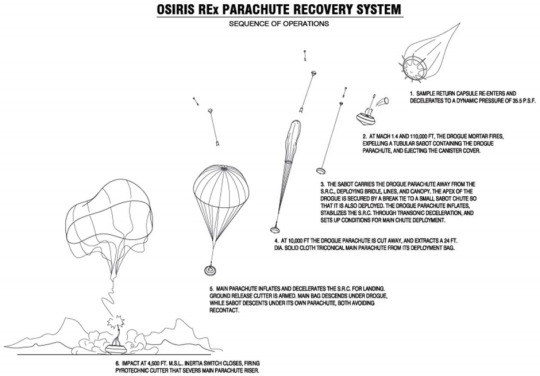

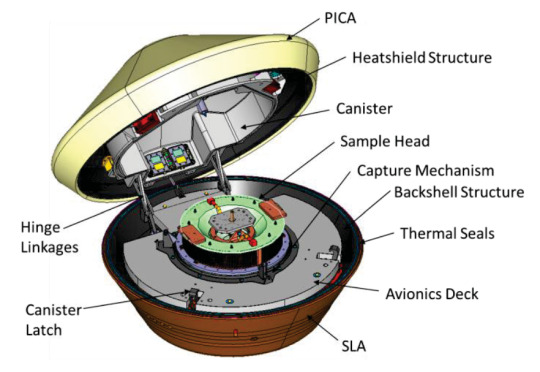
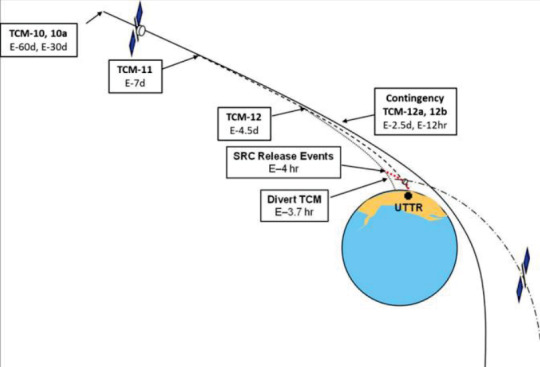

The Sample Return Capsule (SRC) will land today in the Utah Test and Training Range, south west of Utah City.
The OSIRIS Rex (Origins, Spectral Interpretation, Resource Identification, Security, Regolith Explorer) will release the SRC capsule at 11:42 BST (the spacecraft itself will then fire its engine to avoid Earth at 12:02 BST to fly-by at a distance of 485mi so it can continue on another mission). The SRC capsule will enter the Earths atmosphere at 15:42 BST at 12km/sec (feature than an Apollo/Orion reentry from the Moon) and will experience a deceleration of some 32g.
11:42BST (04:42MDT) E-04:00:00 SRC release
12:02 (05:02) E-03:07:00 OSIRIS Rex divert TCM burn (flyby 485mi)
15:00 (08:00) LANDING COVERAGE NASA TV
15:42 (08:42) 14:38:28UT E-0 Entry Interface
E+00:00:51 Maximum heating
E+00:00:61 Maximum G (31.8G)
* At 110,000ft and mach 1.4 drogue chute mortor fires. ejecting the canister cover and expelling a tubular sabot containing the drogue chute.
* Sabot chute deploys pulling out bridle, lines and canopy of drogue chute
E+00:02:25 Drogue Chute Deploy
* Drogue chute inflates, sabot and its chute detach via break tie
* 10,000ft drogue chute detach pulling out 24ft diameter main parachute from its deployment bag
E+00:07:06 Main Chute Deploy
* Main chute inflatesE+00:13:05 Touchdown
Pyrotechnic cutter severs main parachute riser
The recovery team will arrive in four helicopters, first a Lockheed Martin safety engineer will approach the capsule and measure the capsules temperature remotely to ascertain if it is safe to approach, next the atmosphere will be sampled and the area around the capsule will be inspected for any potential hazards.
Them a team from the University of Arizona lead by Principle Investigator Dante Lauretta will cordoned off the area around the Sample Return Capsule (SRC) with flags to denote a keep-out zone and then conduct environmental sampling in that area to build up a library of anything, air, soil, organic matter etc, which could possibly have contaminate the asteroid samples during the landing and recovery.
Once the capsule, weighing 45kg (100 lb), is ready for transport it will be lifted by two people into a metal transport crate and wrapped in multiple layers of Teflon and a tarpaulin. Next the wrapped crate will be fitted with a cargo harness and secured to a lift cable.
This will be attached to a hired Bell Jet Ranger helicopter (in rehearsal's anyway), as a slung load and flown to a hanger at Hill Air Force Base (the range HQ) equipped with a clean room (tent like structure in this case).
There the capsule will be opened and the sample canister will be extracted. The day after both the sample canister and the capsule will be flown to NASA’s Johnson Spaceflight Centre in Houston for storage and from there the sample will be divided and distributed to science investigator teams around the world.
Coverage on NASA TV from 3pm BST (10:00am EDT)... (the picture of the capsule under a parachute is from the recovery rehearsal conducted on 23 August 2023 which was dropped from a helicopter fro the rehearsal)
2 notes
·
View notes
Text
Measuring Moon Dust to Fight Air Pollution - NASA
New Post has been published on https://sunalei.org/news/measuring-moon-dust-to-fight-air-pollution-nasa/
Measuring Moon Dust to Fight Air Pollution - NASA
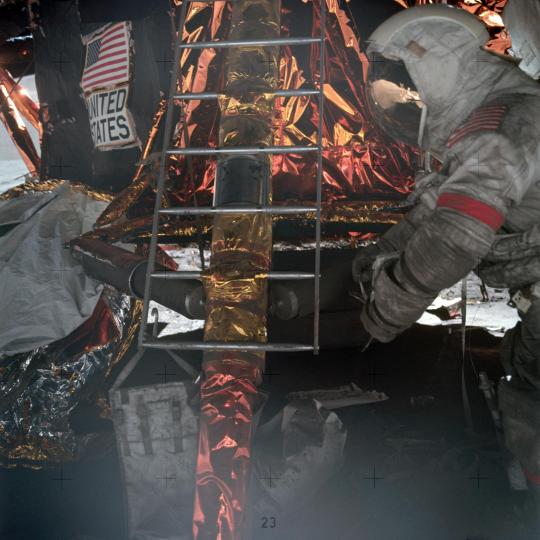
Moon dust, or regolith, isn’t like the particles on Earth that collect on bookshelves or tabletops – it’s abrasive and it clings to everything. Throughout NASA’s Apollo missions to the Moon, regolith posed a challenge to astronauts and valuable space hardware.
During the Apollo 17 mission, astronaut Harrison Schmitt described his reaction to breathing in the dust as “lunar hay fever,” experiencing sneezing, watery eyes, and a sore throat. The symptoms went away, but concern for human health is a driving force behind NASA’s extensive research into all forms of lunar soil.
The need to manage the dust to protect astronaut health and critical technology is already beneficial on Earth in the fight against air pollution.
Working as a contributor on a habitat for NASA’s Next Space Technologies for Exploration Partnerships (NextSTEP) program, Lunar Outpost Inc. developed an air-quality sensor system to detect and measure the amount of lunar soil in the air that also detects pollutants on Earth.
Originally based in Denver, the Golden, Colorado-based company developed an air-quality sensor called the Space Canary and offered the sensor to Lockheed Martin Space for its NextSTEP lunar orbit habitat prototype. After the device was integrated into the habitat’s environmental control system, it provided distinct advantages over traditional equipment.
Rebranded as Canary-S (Solar), the sensor is now meeting a need for low-cost, wireless air-quality and meteorological monitoring on Earth. The self-contained unit, powered by solar energy and a battery, transmits data using cellular technology. It can measure a variety of pollutants, including particulate matter, carbon monoxide, methane, sulfur dioxide, and volatile organic compounds, among others. The device sends a message up to a secure cloud every minute, where it’s routed to either Lunar Outpost’s web-based dashboard or a customer’s database for viewing and analysis.
The oil and gas industry uses the Canary-S sensors to provide continuous, real-time monitoring of fugitive gas emissions, and the U.S. Forest Service uses them to monitor forest-fire emissions.
“Firefighters have been exhibiting symptoms of carbon monoxide poisoning for decades. They thought it was just part of the job,” explained Julian Cyrus, chief operating officer of Lunar Outpost. “But the sensors revealed where and when carbon monoxide levels were sky high, making it possible to issue warnings for firefighters to take precautions.”
The Canary-S sensors exemplify the life-saving technologies that can come from the collaboration of NASA and industry innovations.
0 notes
Text
LEGO-inspired space bricks pave the way for lunar construction
New Post has been published on https://sa7ab.info/2024/08/16/lego-inspired-space-bricks-pave-the-way-for-lunar-construction/
LEGO-inspired space bricks pave the way for lunar construction


The dream of establishing permanent structures on the moon has captivated scientists and space enthusiasts for decades. With the challenges of building in such an extreme environment, researchers are compelled to innovate and explore new possibilities.One of the most exciting developments comes from the European Space Agency (ESA), which has created 3D-printed bricks inspired by LEGO, made from 4.5-billion-year-old meteorite dust. These ESA Space Bricks represent a significant step toward sustainable lunar construction and could pave the way for future lunar settlements.SIGN UP FOR FOR KURT’S FREE NEWSLETTER AND GET INSTANT ACCESS TO THE CYBERGUY REPORTThe idea behind the ESA Space Bricks is straightforward yet revolutionary. Instead of transporting building materials from Earth, why not use the resources already available on the Moon? The lunar surface is covered in a layer of rock and mineral fragments known as lunar regolith, which could potentially be transformed into building materials. However, the challenge lies in the fact that there is very little lunar regolith available on Earth for experimentation.CLICK HERE FOR MORE U.S. NEWSUndeterred by the lack of lunar materials, ESA scientists devised an innovative solution. They created a synthetic version of lunar regolith by grinding up a 4.5-billion-year-old meteorite. This meteorite, discovered in Northwest Africa, is rich in space materials and served as the perfect foundation for their 3D-printed bricks. By mixing this meteorite dust with a polylactide and regolith simulant, the team successfully created bricks that mimic the properties of LEGO bricks.NASA’S DRAGONFLY DRONE CLEARED FOR FLIGHT TO SATURN’S MOON, TITAN ESA’s Space Bricks are designed to interlock and click together just like traditional LEGO bricks, allowing for a range of construction possibilities. While they may appear a bit rougher and are only available in a stylish space gray, their functionality remains intact. This modular design enables scientists to experiment with various building techniques and structures, fostering creativity and innovation in lunar construction.HOW TO REMOVE YOUR PRIVATE DATA FROM THE INTERNET SUIT UP FOR THE STARS: SPACEX’S NEW ERA OF SPACE FASHION As ESA Science Officer Aidan Cowley noted, “Nobody has built a structure on the moon, so it was great to have the flexibility to try out all kinds of designs and building techniques with our space bricks.” This playful approach not only aids in scientific understanding but also encourages a spirit of exploration and creativity that is essential in space engineering.GET FOX BUSINESS ON THE GO BY CLICKING HEREESA is showcasing these remarkable space bricks in select LEGO stores worldwide, from June 24 to Sept. 20 to further engage the public and inspire future generations of space engineers. This initiative aims to spark interest in space exploration and engineering among children, encouraging them to imagine and create their own lunar bases using LEGO.The development of ESA’s Space Bricks represents an exciting step forward in our journey to build sustainable habitats on the moon. By using materials found right there on the lunar surface and embracing some really creative design ideas, scientists are not just laying the groundwork for future lunar homes but also sparking the imaginations of the next generation of builders and dreamers.After reading about ESA’s Space Bricks and the potential for building on the moon, do you think you would want to live there someday? ContactFor more of my tech tips and security alerts, Follow Kurt on his social channels. .
0 notes
Text
Earth is constantly bombarded by fragments of rock and ice that have drifted from space, known as meteoroids. Most of these are about the size of a grain of sand or a pebble, and burn up completely high in the atmosphere. Meteoroids larger than a golf ball can be meteor Or a shooting star On a dark and clear night.While very small meteorites are common, meteorites larger than a dishwasher are not uncommon.The meteor is Aerospace and Geophysicist Normally, man-made objects are not suitable for study because it is impossible to predict when and where they will hit the atmosphere. However, on very rare occasions, it is possible to study man-made objects that enter the atmosphere, such as meteorites. These objects are space A mission designed to deliver samples of extraterrestrial material from space EarthDue to its similarity to a meteorite's impact, the Sample Return Capsule (SRC) is often referred to as the "artificial meteorite."Recently, more than 80 researchers from more than a dozen institutions collaborated to study such "artificial meteors." NASA's OSIRIS-REx sample return capsule – It occurred upon re-entering Earth's atmosphere.Related: The first examination of samples from the asteroid Bennu suggests the space rocks could be "fragments of an ancient ocean world."These institutions include Sandia National LaboratoriesNASA Jet Propulsion Laboratory, Los Alamos National Laboratory, Defense Threat Reduction Agency, TDA Research Inc., University of Hawaii, Air Force Research Laboratory, Black Nest Nuclear Weapons Facility, Boise State University, Idaho National Laboratory, Johns Hopkins University, Kochi University of Technology, Nevada National Security Site, Southern Methodist University, University of Memphis and Oklahoma State University.The latest space news, rocket launch updates, astronomy events, and more!This sample return gave our team a unique opportunity to measure sound waves and other phenomena generated by objects from space as they pass through Earth's atmosphere.To capture the signals, numerous highly sensitive microphones and other equipment were placed at strategic locations close to SRC's flight path.While space agencies and private companies launch objects into space, time, Osiris Rex The SRC is one of the few objects to have returned to Earth from interplanetary space since the end of the Apollo program, as these are the only objects capable of achieving the same speeds as natural meteoroids. Their re-entry is valuable. To study the properties of natural objects. Asteroid sample collection National Aeronautics and Space Administration (NASA) Origin, Spectral Interpretation, Resource Identification, Security, Regolith Explorer, or Osiris RexThe mission was completed on September 8, 2016. Near-Earth Asteroid Bennuand samples were taken from its surface in October 2020. Specimen, sample Returned to Earth Launched in a sample return capsule in the early morning of September 24, 2023, the SRC re-entered the atmosphere over the Pacific Ocean at speeds of more than 27,000 miles per hour (43,500 kilometers per hour), landing in Utah just minutes later. A close-up of the OSIRIS-REx sample capsule on the ground in Utah. (Image courtesy of Mark Koenig/University of Arizona)SRC generates shock waves As it penetrates deeper into the atmosphere, a shock wave appears that resembles the sonic boom produced by a supersonic jet plane. Breaking the sound barrierThe shock wave then subsides, leaving only a low frequency sound. It is called infrasound.Humans cannot hear infrasound, but sensitive scientific instruments can detect it from great distances. These instruments can be ground-based or suspended in the air from balloons.Observation of SRC Our team of scientists saw the SRC's re-entry as an opportunity to learn more about meteors. Siddharth Krishnamoorthi NASA Jet Propulsion Laboratoryused the SRC's re-entry to test an infrasound detection balloon that could later be used in space. Venus.Another
team led by one of us – Elizabeth Silver - and Danny Bowman Researchers at Sandia National Laboratories used the SRC to better understand how sound can be harnessed. [gather information about meteoroids].These observation campaigns involved researchers from many institutions across the country.Our team strategically placed instruments over a 300-mile (482 km) stretch from Eureka, Nevada, to near the landing site in Utah. The instruments ranged from high-tech, custom sensors to smartphones on the ground around the SRC's flight path and landing site to monitor infrasound waves during SRC re-entry.In addition to ground-based sensors, the researchers mounted instruments on balloons that floated at twice the altitude of a commercial airliner during the SRC's re-entry. These balloon-mounted sensors recorded sound waves generated by the SRC's shock wave. These sound waves conveyed information about the SRC, its movements, and the environment it passed through.One of the balloons launched early in the morning, equipped with sensors to detect infrasound emitted by the OSIRIS-REx capsule as it re-enters. (Image courtesy of Emmalee Huff)The balloon team had to time it carefully to make sure the balloon was in the right position when the SRC passed by. NASA Jet Propulsion Laboratory, Oklahoma State University and Sandia National Laboratories Several types of balloons were launched before dawn from Eureka, Nevada.OSU, Sandia National Laboratories, University of Hawaii They also placed ground-based infrasound sensors at the Utah-Nevada border, close to the SRC's landing site, and at Wendover Airport, which detected clear infrasound signals even though SRC had already slowed and Wendover Airport was about three times farther down the flight path than the Eureka site.Researchers from these teams are currently analyzing the data to identify the points in orbit where instruments recorded the SRC re-entry signal. Because the SRC's flight path was approximately 300 miles (482 km), researchers need to determine where the signal originated when it was detected by various sensors.This is the most measured Historical hypersonic reentries.This work will help our team understand the pattern in which the low-frequency sound waves propagated through the atmosphere and where the shock waves peaked.Team members from the University of Hawaii and Oklahoma State University during the deployment at Wendover Airport. (Image courtesy of Milton A. Garces)Our team is still analyzing the data, but preliminary results show that our instrument captured many signals that will be useful for future research using infrasound waves to study meteors.By understanding the complex mechanisms behind how low-frequency sound waves travel through the atmosphere, researchers could use infrasound to detect dangers on Earth. Tornadoes, etc. avalanche.
0 notes
Text
Sorprendente hallazgo de fosfato en la muestra del asteroide OSIRIS-REx de la NASA
Si bien se encontró un fosfato similar en la muestra del asteroide Ryugu entregada por la misión Hayabusa2 de JAXA (Agencia de Exploración Aeroespacial de Japón) en 2020, el fosfato de magnesio y sodio detectado en la muestra de Bennu destaca por su purez
Los científicos han esperado ansiosamente la oportunidad de profundizar en la prístina muestra del asteroide Bennu de 4,3 onzas (121,6 gramos) recolectada por la misión OSIRIS-REx (Origins, Spectral Interpretation, Resource Identification, and Security—Regolith Explorer) de la NASA desde que fue entregada a la Tierra. el otoño pasado. Esperaban que el material contuviera secretos del pasado del…

View On WordPress
0 notes
Text
A Very Important and Special Box of Rocks 🪨
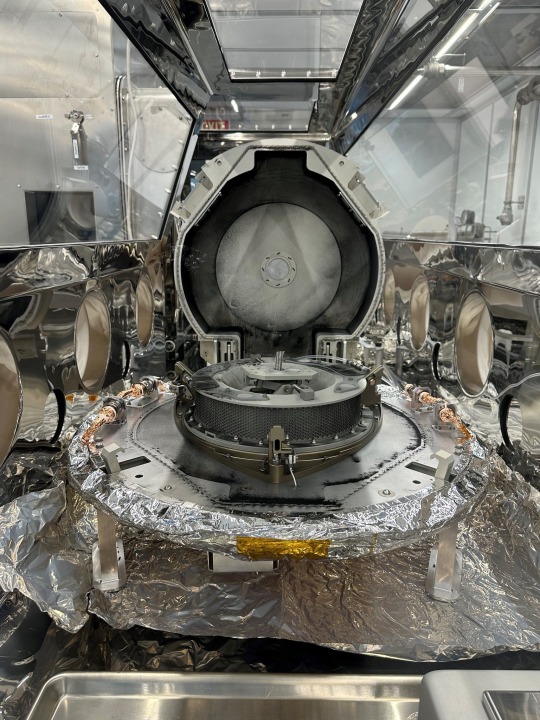
NASA’s OSIRIS-REx (Origins, Spectral Interpretation, Resource Identification and Security – Regolith Explorer) has been opened!
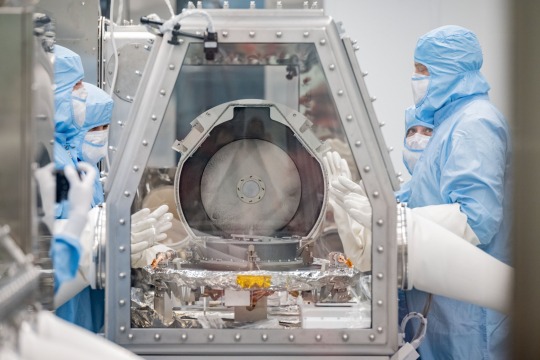
NASA scientists found black dust and debris on the avionics deck of the OSIRIS-REx science canister when the initial lid was removed today. The canister from the OSIRIS-REx sample return capsule was delivered to NASA’s Johnson Space Center in Houston on Sept. 25 after landing in the Utah desert on Sept. 24
With an array of team members on deck, scientists and engineers at Johnson will work together to complete the disassembly process and reveal the sample to the world in a special live broadcast event on Oct. 11 at 11 a.m. ET, streamed at NASA.gov/live
3 notes
·
View notes
Text

Mini lab secures NASA ride to the moon
A miniaturized laboratory developed by The Open University (OU) with support from RAL Space will fly to the lunar South Polar region in the European Space Agency's (ESA) Prospect package in search of volatiles, including water ice, as part of NASA's Commercial Lunar Payload Services initiative.
NASA has selected Intuitive Machines to deliver six payloads that will deepen our understanding of the moon and answer key questions about where and how volatiles can be found on the lunar surface. Volatiles, such as water ice, are chemical components that easily evaporate or vaporize under certain conditions.
Prospect is a suite of instruments that will drill up to at least 1 meter depth beneath the lunar surface, extract samples, and process them in a mini lab, ProSPA. The combination of robotic drill and sample analysis package is designed to identify volatiles trapped beneath the surface at extremely cold temperatures down to –150°C.
Chris Howe, Production and Software Group Leader at RAL Space, said, "The technology behind ProSPA is the result of years of collaboration between RAL Space and the Open University, and we're delighted that this latest milestone is bringing the instrument one step closer to the moon.
"ProSPA will not only build on the legacy of previous projects, such as PITMS, but the insights we gain from it will also support future missions advancing our understanding of the lunar surface. It's a really exciting project to be part of."
Europe's major contribution will share the ride with five other instruments from the US, including retroreflectors to locate landing sites on the moon and yeast to study radiation and gravity responses. In total, the six instruments will have a mass of about 80 kg.
Volatiles for sustainable exploration
Prospect is part of a global effort to identify potential lunar resources for a sustainable, long-term human presence on the moon.
Water is a key target: There may be concentrations of frozen water at or below the surface especially in the lunar polar regions—something suggested by recent measurements from orbit. Information on how much water is present and how accessible it is would help plan future missions using local resources.
"Prospect joins a new wave of lunar science and exploration that could open the door to the use of lunar resources. For example, extracting oxygen directly from lunar rocks and dust could be an efficient way to supply oxygen for human habitats or spacecraft propulsion," says Richard Fisackerly, Prospect project manager.
"Besides their potential as resources, lunar volatiles would also represent an important component of the lunar regolith—the layer of loose dust and fragmented rock on the moon's surface. Prospect can further our understanding of the fundamental science of the moon and its environment," he adds.
Drilling and sample analysis
The robotic drill, called ProSEED, will penetrate the lunar surface up to one meter depth. Temperatures at the subsurface are expected to be less than –100°C, and correspond with conditions where water ice may be stable. The drill features a multispectral imager and a permittivity sensor to support the remote detection and analysis of volatiles, as well as the mineralogy of the regolith at the landing site.
The miniaturized laboratory ProSPA will receive the samples from the drill via a carousel with multiple ovens, seal them, and heat them to extract the cold-trapped volatiles. The ProSPA instrument will then measure the nature and abundance of lunar volatiles using the gases released from the sample. ProSPA will also test specific processes which could be applied for resource extraction in the future.
Dr. Simeon Barber, who leads the project at The Open University, said, "After more than a decade of developing the ProSPA concept and instrument, our team is super-excited to be hitching a ride to the moon. We look forward to analyzing fresh samples drilled from the moon's south polar region, which might contain ancient reserves of water and other ices. And we can't wait to unravel the mysteries of this extreme environment, and discover its potential to support future exploration missions."
One step closer to prospecting the moon
The ProSEED drill has already undergone trials in Italy including tests conducted at very low temperatures, under low pressure, and using a mixture of lunar regolith simulant and water ice.
These tests have proved the drill is capable of penetrating deep into hard material and successfully collect samples.
IMAGE: An artist's concept of Intuitive Machines' Nova-C lunar lander on the moon's South Pole. Credit: Intuitive Machines
0 notes
Text
Surprising Phosphate Finding in NASAs OSIRIS-REx Asteroid Sample
Scientists have eagerly awaited the opportunity to dig into the 4.3-ounce (121.6-gram) pristine asteroid Bennu sample collected by NASA’s OSIRIS-REx (Origins, Spectral Interpretation, Resource Identification, and Security – Regolith Explorer) mission since it was delivered to Earth last fall. They hoped the material would hold secrets of the solar system’s past and the prebiotic chemistry […]
from NASA https://ift.tt/LYKk6E5
0 notes